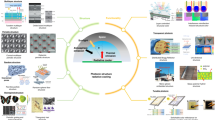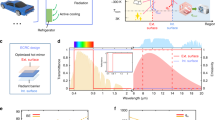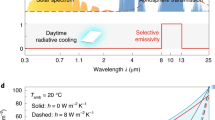Abstract
Cooling is a significant end-use of energy globally and a major driver of peak electricity demand. Air conditioning, for example, accounts for nearly fifteen per cent of the primary energy used by buildings in the United States1. A passive cooling strategy that cools without any electricity input could therefore have a significant impact on global energy consumption. To achieve cooling one needs to be able to reach and maintain a temperature below that of the ambient air. At night, passive cooling below ambient air temperature has been demonstrated using a technique known as radiative cooling, in which a device exposed to the sky is used to radiate heat to outer space through a transparency window in the atmosphere between 8 and 13 micrometres2,3,4,5,6,7,8,9,10,11. Peak cooling demand, however, occurs during the daytime. Daytime radiative cooling to a temperature below ambient of a surface under direct sunlight has not been achieved3,4,12,13 because sky access during the day results in heating of the radiative cooler by the Sun. Here, we experimentally demonstrate radiative cooling to nearly 5 degrees Celsius below the ambient air temperature under direct sunlight. Using a thermal photonic approach14,15,16,17,18,19,20,21,22,23,24,25, we introduce an integrated photonic solar reflector and thermal emitter consisting of seven layers of HfO2 and SiO2 that reflects 97 per cent of incident sunlight while emitting strongly and selectively in the atmospheric transparency window. When exposed to direct sunlight exceeding 850 watts per square metre on a rooftop, the photonic radiative cooler cools to 4.9 degrees Celsius below ambient air temperature, and has a cooling power of 40.1 watts per square metre at ambient air temperature. These results demonstrate that a tailored, photonic approach can fundamentally enable new technological possibilities for energy efficiency. Further, the cold darkness of the Universe can be used as a renewable thermodynamic resource, even during the hottest hours of the day.
This is a preview of subscription content, access via your institution
Access options
Subscribe to this journal
Receive 51 print issues and online access
$199.00 per year
only $3.90 per issue
Buy this article
- Purchase on Springer Link
- Instant access to full article PDF
Prices may be subject to local taxes which are calculated during checkout




Similar content being viewed by others
References
Kelso, J. K. (ed.) 2011 Buildings Energy Data Bookhttp://buildingsdatabook.eren.doe.gov/docs/DataBooks/2011_BEDB.pdf (US Department of Energy, Office of Energy Efficiency and Renewable Energy, 2011)
Trombe, F. Perspectives sur l’utilisation des rayonnements solaires et terrestres dans certaines régions du monde. Revue Générale Thermique 6, 1285–1314 (1967)
Catalanotti, S. et al. The radiative cooling of selective surfaces. Sol. Energy 17, 83–89 (1975)
Bartoli, B. et al. Nocturnal and diurnal performances of selective radiators. Appl. Energy 3, 267–286 (1977)
Granqvist, C. G. & Hjortsberg, A. Surfaces for radiative cooling: silicon monoxide films on aluminum. Appl. Phys. Lett. 36, 139–141 (1980)
Granqvist, C. G. & Hjortsberg, A. Radiative cooling to low temperatures: general considerations and application to selectively emitting SiO films. J. Appl. Phys. 52, 4205–4220 (1981)
Berdahl, P., Martin, M. & Sakkal, F. Thermal performance of radiative cooling panels. Int. J. Heat Mass Transf. 26, 871–880 (1983)
Berdahl, P. Radiative cooling with MgO and/or LiF layers. Appl. Opt. 23, 370–372 (1984)
Orel, B., Gunde, M. & Krainer, A. Radiative cooling efficiency of white pigmented paints. Sol. Energy 50, 477–482 (1993)
Gentle, A. R. & Smith, G. B. Radiative heat pumping from the earth using surface phonon resonant nanoparticles. Nano Lett. 10, 373–379 (2010)
Gentle, A., Aguilar, J. & Smith, G. Optimized cool roofs: integrating albedo and thermal emittance with R-value. Sol. Energy Mater. Sol. Cells 95, 3207–3215 (2011)
Nilsson, T. M. & Niklasson, G. A. Radiative cooling during the day: simulations and experiments on pigmented polyethylene cover foils. Sol. Energy Mater. Sol. Cells 37, 93–118 (1995)
Nilsson, T. M., Niklasson, G. A. & Granqvist, C. G. A solar reflecting material for radiative cooling applications: ZnS pigmented polyethylene. Sol. Energy Mater. Sol. Cells 28, 175–193 (1992)
Rephaeli, E., Raman, A. & Fan, S. Ultrabroadband photonic structures to achieve high-performance daytime radiative cooling. Nano Lett. 13, 1457–1461 (2013)
Lin, S.-Y. et al. Enhancement and suppression of thermal emission by a three-dimensional photonic crystal. Phys. Rev. B 62, R2243–R2246 (2000)
Greffet, J.-J. et al. Coherent emission of light by thermal sources. Nature 416, 61–64 (2002)
Narayanaswamy, A. & Chen, G. Thermal emission control with one-dimensional metallodielectric photonic crystals. Phys. Rev. B 70, 125101 (2004)
Luo, C., Narayanaswamy, A., Chen, G. & Joannopoulos, J. D. Thermal radiation from photonic crystals: a direct calculation. Phys. Rev. Lett. 93, 213905 (2004)
Lee, B. J., Fu, C. J. & Zhang, Z. M. Coherent thermal emission from one-dimensional photonic crystals. Appl. Phys. Lett. 87, 071904 (2005)
Drevillon, J. & Ben-Abdallah, P. Ab initio design of coherent thermal sources. J. Appl. Phys. 102, 114305 (2007)
Schuller, J., Taubner, T. & Brongersma, M. Optical antenna thermal emitters. Nature Photon. 3, 658–661 (2009)
Rephaeli, E. & Fan, S. Absorber and emitter for solar thermo-photovoltaic systems to achieve efficiency exceeding the Shockley-Queisser limit. Opt. Express 17, 15145–15159 (2009)
Wu, C. et al. Metamaterial-based integrated plasmonic absorber/emitter for solar thermo-photovoltaic systems. J. Opt. 14, 024005 (2012)
De Zoysa, M. et al. Conversion of broadband to narrowband thermal emission through energy recycling. Nature Photon. 6, 535–539 (2012)
Lenert, A. et al. A nanophotonic solar thermophotovoltaic device. Nature Nanotechnol. 9, 126–130 (2014)
Berk, A. et al. Modtran5: 2006 update. Proc. SPIE 6233, 62331F (2006)
Martin, M. & Berdahl, P. Characteristics of infrared sky radiation in the United States. Sol. Energy 33, 321–336 (1984)
Bright, T., Watjen, J., Zhang, Z., Muratore, C. & Voevodin, A. Optical properties of HfO2 thin films deposited by magnetron sputtering: from the visible to the far-infrared. Thin Solid Films 520, 6793–6802 (2012)
Jacob, Z. et al. Engineering photonic density of states using metamaterials. Appl. Phys. B 100, 215–218 (2010)
Isaac, M. & van Vuuren, D. P. Modeling global residential sector energy demand for heating and air conditioning in the context of climate change. Energy Policy 37, 507–521 (2009)
Tikhonravov, A. V., Trubetskov, M. K. & DeBell, G. W. Application of the needle optimization technique to the design of optical coatings. Appl. Opt. 35, 5493–5508 (1996)
Palik, E. Handbook of Optical Constants of Solids (Academic Press Handbook Series, Elsevier Science & Tech, 1985)
Crawley, D. B., Pedersen, C. O., Lawrie, L. K. & Winkelmann, F. C. Energyplus: Energy simulation program. ASHRAE J. 42, 49–56 (2000)
Deru, M. et al. US Department of Energy commercial reference building models of the national building stock. Tech. Rep. NREL/TP-5500-46861, http://www.nrel.gov/docs/fy11osti/46861.pdf (National Renewable Energy Laboratory, 2011)
Marion, W. & Urban, K. User’s manual for TMY2s. Tech. Rep. http://rredc.nrel.gov/solar/pubs/tmy2/PDFs/tmy2man.pdf (National Renewable Energy Laboratory, 1995)
Campbell, M. Charting the progress of PV power plant energy generating costs to unsubsidized levels, introducing the PV-LCOE framework. In Proc. 26th Eur. Photovoltaic Solar Energy Conf. (Hamburg) 4409–4419 (2011)
Keshner, M. S. & Arya, R. R. Study of potential cost reductions resulting from super-large-scale manufacturing of PV modules. Tech. Rep., Final Subcontract Report NREL/SR-520–36846 (National Renewable Energy Laboratory, 2004)
Bazilian, M. et al. Re-considering the economics of photovoltaic power. Renew. Energy 53, 329–338 (2013)
Acknowledgements
This work is supported by the Advanced Research Projects Agency-Energy (ARPA-E), Department of Energy (contract number DE-AR0000316). We acknowledge discussions with J. Eaton and K. Goodson. Part of this work was performed at the Stanford Nanofabrication Facility, which is supported by the National Science Foundation through the NNIN under grant number ECS-9731293, and the Stanford Nano Center (SNC)/Stanford Nanocharacterization Laboratory (SNL), part of the Stanford Nano Shared Facilities.
Author information
Authors and Affiliations
Contributions
A.P.R. and S.F. envisioned and implemented the experimental studies, and wrote the manuscript. A.P.R. and M.A.A. built and executed the rooftop experiments. A.P.R. designed and characterized the radiative cooler. L.Z. and E.R. provided technical support and conceptual advice.
Corresponding authors
Ethics declarations
Competing interests
The authors declare no competing financial interests.
Extended data figures and tables
Extended Data Figure 1 Angular emissivity of photonic radiative cooler.
a, Measured emissivity/absorptivity of the cooler for variable angles of incidence over near- and mid-infrared wavelengths with a realistic atmospheric transmittance model plotted for reference26. b, Average measured emissivity  of the photonic radiative cooler between 8 µm and 13 µm (the atmospheric transparency window) plotted as a function of polar angle of incidence. The cooler’s emissivity within the window remains relatively constant between 5° and 60°, and remains high even at remarkably large angles of incidence, reminiscent of the behaviour of hyperbolic metamaterials.
of the photonic radiative cooler between 8 µm and 13 µm (the atmospheric transparency window) plotted as a function of polar angle of incidence. The cooler’s emissivity within the window remains relatively constant between 5° and 60°, and remains high even at remarkably large angles of incidence, reminiscent of the behaviour of hyperbolic metamaterials.
Extended Data Figure 2 Numerical modelling of non-radiative heat exchange.
a, A numerical simulation of the apparatus and radiative cooler (layout shown at top) yields a temperature distribution (Tsample − Tambient) (bottom) within the geometry that takes into account non-radiative heat exchange in the apparatus. b, The simulation calculation for Pcond+conv as a function of Tsample − Tambient (blue line) yields a value of hc = 6.9 W m−2 K−1, which we use in our theoretical model to compare against experimental data in Fig. 4b. We also plot the theoretical model of net radiated power Pnet that is based on the absorption/emission of the photonic radiative cooler (grey line). The intersection represents the predicted value of Ts of the photonic radiative cooler in this apparatus, and matches well our observed experimental value of Ts = 4.3 °C below ambient in Fig. 4b. c, Theoretical model plotted for various values of hc. As hc → 0 the model predicts Ts of nearly 20 °C below ambient can be achieved by the photonic radiative cooler.
Extended Data Figure 3 Modelling steady-state temperature under daytime and night-time conditions.
a, The theoretical model is used to calculate the steady-state temperature of the photonic radiative cooler (see Methods) given observed air temperatures, solar irradiance and a range of values of hc from 4 W m−2 K−1 to 8 W m−2 K−1 (grey band). The model is able to predict well the observed performance of the photonic radiative cooler through the course of the day (blue line, extending the data from Fig. 2) under both direct solar irradiance (green line) and when the Sun sets behind nearby hills, reducing irradiance to near-zero values. b, Data from this latter time period (effectively night-time conditions). As expected, the photonic cooler performs even better under no solar irradiance, with Tsample − Tambient of approximately 7 °C below ambient achieved. c, The four terms on the right hand side of equation (1) are plotted, using the model at Ts as a function of time, to elucidate the impact of each component on performance.
Extended Data Figure 4 Energy savings for a medium commercial reference building with photonic radiative coolers.
We use a simple approach to estimate the energy savings for the National Renewable Energy Laboratory three-story commercial benchmark building31, assuming its 1,600 m2 roof is covered with the photonic radiative cooler, and heat from its interior is transferred to the radiative panels (see Methods). Using the model of our photonic radiative cooler, the thermal cooling power of the radiative cooler is set relative to ambient air temperature and solar irradiance for Phoenix, Arizona, over a typical year (TMY2 data), and with an interior air temperature of 24° C. EnergyPlus simulations determine the cooling load the building places on the air-conditioning units (which is assumed to have a coefficient of performance of 2.8). The calculated cooling power of the radiative cooler is then subtracted from the thermal load on an hourly basis for the year, and electricity savings are subsequently inferred and plotted. Although this is a rudimentary analysis, it does indicate that more kilowatt hours are saved in summer months where there is greater cooling demand, and that the scale of the potential annual savings (1.185 × 105 kWh) is substantial.
Rights and permissions
About this article
Cite this article
Raman, A., Anoma, M., Zhu, L. et al. Passive radiative cooling below ambient air temperature under direct sunlight. Nature 515, 540–544 (2014). https://doi.org/10.1038/nature13883
Received:
Accepted:
Published:
Issue Date:
DOI: https://doi.org/10.1038/nature13883
This article is cited by
-
Infrared-reflective ultrathin-metal-film-based transparent electrode with ultralow optical loss for high efficiency in solar cells
Scientific Reports (2024)
-
Bilateral passive thermal management for dynamical temperature regulation
Scientific Reports (2024)
-
A dual-selective thermal emitter with enhanced subambient radiative cooling performance
Nature Communications (2024)
-
Superhydrophobic daytime radiative cooling coating incorporated with phase change microcapsules for building thermal regulation
Journal of Materials Science (2024)
-
The effects of cool materials, façade orientation, and morphological parameters on energy consumption at the residential neighborhood scale
Building Simulation (2024)
Comments
By submitting a comment you agree to abide by our Terms and Community Guidelines. If you find something abusive or that does not comply with our terms or guidelines please flag it as inappropriate.



